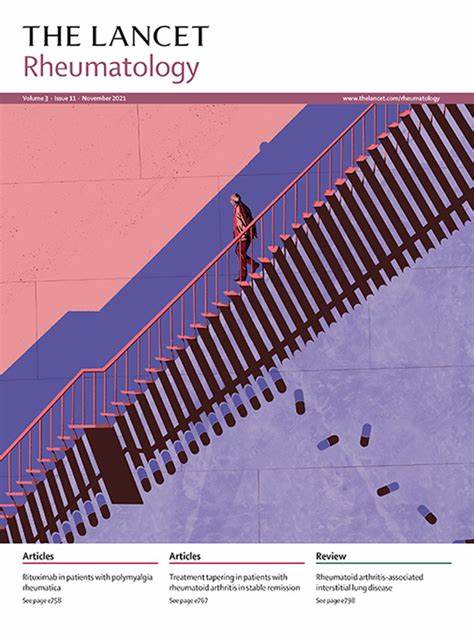Clinical and cost-effectiveness of a cycling and education intervention versus usual physiotherapy care for the treatment of hip osteoarthritis in the UK (CLEAT): a pragmatic, randomised, controlled trial
IF 16.4
1区 医学
Q1 RHEUMATOLOGY
引用次数: 0
Abstract
Background
Osteoarthritis of the hip is a leading cause of chronic disability. The cycling and education intervention (CLEAT) trial aimed to compare the clinical and cost-effectiveness of the cycling against hip pain (CHAIN) intervention, a group-based cycling and education programme, with usual physiotherapy care for patients with hip osteoarthritis referred for physiotherapy at a UK hospital.
Methods
CLEAT was a pragmatic, single-centre, randomised controlled trial done in Bournemouth, UK. Patients older than 18 years with activity-related joint pain, either no morning stiffness or morning stiffness lasting no longer than 30 min, and who met the primary-care criteria for exercise referral were eligible to participate. Patients aged 18–45 years were only eligible to participate if an x-ray confirmed the presence of hip osteoarthritis. Participants were randomly assigned (1:1) to either the CHAIN intervention or usual physiotherapy care using random permuted blocks of sizes 2, 4, and 6. Participants in the CHAIN intervention group attended an 8-week group programme at a local leisure centre comprised of education and static cycling. Participants in the physiotherapy group had usual one-to-one care with a physiotherapist at the local hospital or by telephone, depending on usual care at the time of treatment. The primary outcome was the difference in Hip Disability and Osteoarthritis Outcome Score (HOOS) activities of daily living subscale at 10 weeks post-treatment (visit 4) between groups. The trial included a parallel economic evaluation from the primary perspective of the UK NHS and personal social services. All participants who provided data at visit 4 were included in the efficacy analysis, and data on safety and adverse events were collected between baseline and visit 4. People with lived experience of hip osteoarthritis were involved in the design and management of the study. This trial is registered with ISRCTN (ISRCTN19778222).
Findings
Between Feb 24, 2020, and April 28, 2023, 221 participants were recruited to the study and randomly assigned to the CHAIN intervention (110 [50%]) or usual physiotherapy care (111 [50%]). 126 (57%) participants were female, 95 (43%) were male, 217 (98%) were White, and the mean age was 64·4 years (SD 9·5). Participants in the CHAIN group had greater improvements in mean HOOS activities of daily living subscale scores (from 60·8 [SD 19·2] at baseline to 73·5 [20·0] at 10 weeks) compared with participants in the usual physiotherapy care group (from 59·3 [19·6] to 65·4 [19·9]; adjusted mean difference 6·9 [95% CI 2·5–11·2]; p=0·0023). Although the primary outcome showed a statistically significant improvement for CHAIN over usual physiotherapy, the between-group difference of 6·9 HOOS points did not meet the pre-defined minimum clinically important difference of 7·4. CHAIN cost £4092 per quality-adjusted life year gained compared with usual physiotherapy care, below the £20 000 to £30 000 National Institute of Health and Care Excellence threshold for cost-effectiveness. There were no treatment-related serious adverse events.
Interpretation
The CHAIN intervention showed superior outcomes compared with usual physiotherapy care, and the feasibility of delivering a low-cost, community-based intervention within the NHS was shown. However, longer-term benefits and broader generalisability warrant further investigation.
Funding
The National Institute for Health and Care Research for Patient Benefit Programme.
英国(CLEAT):一项实用、随机、对照试验:骑车和教育干预与常规物理治疗治疗髋关节骨关节炎的临床和成本效益。
背景:髋关节骨关节炎是慢性残疾的主要原因。骑车和教育干预(CLEAT)试验旨在比较骑车治疗髋关节疼痛(CHAIN)干预的临床和成本效益,这是一项基于小组的骑车和教育计划,与在英国一家医院转介进行物理治疗的髋关节骨关节炎患者的常规物理治疗护理。方法:CLEAT是在英国伯恩茅斯进行的一项实用、单中心、随机对照试验。年龄大于18岁,伴有活动相关关节疼痛,无晨僵或晨僵持续时间不超过30分钟,且符合运动转诊的初级保健标准的患者有资格参加研究。年龄在18-45岁的患者只有在x光片证实存在髋关节骨关节炎时才有资格参加研究。参与者被随机(1:1)分配到CHAIN干预或常规物理治疗护理中,使用大小为2、4和6的随机排列块。CHAIN干预组的参与者在当地的一个休闲中心参加了一个为期8周的团体活动,包括教育和静态骑自行车。物理治疗组的参与者通常在当地医院接受物理治疗师的一对一护理,或通过电话,这取决于治疗时的常规护理。主要结局是治疗后10周(第4次访问)各组髋关节残疾和骨关节炎结局评分(HOOS)日常生活活动亚量表的差异。该试验包括从英国国民保健服务和个人社会服务的主要角度进行平行经济评估。所有在第4次就诊时提供数据的参与者都被纳入疗效分析,从基线到第4次就诊期间收集安全性和不良事件的数据。有髋关节骨关节炎生活经验的人参与了研究的设计和管理。该试验已在ISRCTN注册(ISRCTN19778222)。研究结果:在2020年2月24日至2023年4月28日期间,221名参与者被招募到研究中,并随机分配到CHAIN干预组(110名[50%])或常规物理治疗组(111名[50%])。女性126例(57%),男性95例(43%),白人217例(98%),平均年龄64.4岁(SD 9.5)。与常规物理治疗护理组的参与者(从59.3[19.6]到65.4[19.9])相比,CHAIN组的参与者在日常生活亚量表的平均HOOS活动得分(从基线时的60·8 [SD 19.2]到10周时的73.5[20.0])有更大的改善;调整后平均差为6.9 [95% CI为2.5 - 11.2];p = 0·0023)。虽然主要结局显示CHAIN比常规物理治疗有统计学意义的改善,但组间差异为6.9个HOOS点,未达到预定的最小临床重要差异为7.4。与通常的物理治疗护理相比,CHAIN每个质量调整生命年的成本为4092英镑,低于国家健康和护理卓越研究所的成本效益门槛2万至3万英镑。没有与治疗相关的严重不良事件。解释:与常规物理治疗护理相比,CHAIN干预显示出更好的结果,并且在NHS内提供低成本、基于社区的干预的可行性得到了证明。然而,长期效益和更广泛的普遍性值得进一步研究。资助:国家保健和护理研究所病人福利方案。
本文章由计算机程序翻译,如有差异,请以英文原文为准。
求助全文
约1分钟内获得全文
求助全文
来源期刊

Lancet Rheumatology
RHEUMATOLOGY-
CiteScore
34.70
自引率
3.10%
发文量
279
期刊介绍:
The Lancet Rheumatology, an independent journal, is dedicated to publishing content relevant to rheumatology specialists worldwide. It focuses on studies that advance clinical practice, challenge existing norms, and advocate for changes in health policy. The journal covers clinical research, particularly clinical trials, expert reviews, and thought-provoking commentary on the diagnosis, classification, management, and prevention of rheumatic diseases, including arthritis, musculoskeletal disorders, connective tissue diseases, and immune system disorders. Additionally, it publishes high-quality translational studies supported by robust clinical data, prioritizing those that identify potential new therapeutic targets, advance precision medicine efforts, or directly contribute to future clinical trials.
With its strong clinical orientation, The Lancet Rheumatology serves as an independent voice for the rheumatology community, advocating strongly for the enhancement of patients' lives affected by rheumatic diseases worldwide.
 求助内容:
求助内容: 应助结果提醒方式:
应助结果提醒方式:


